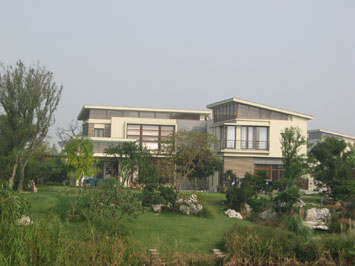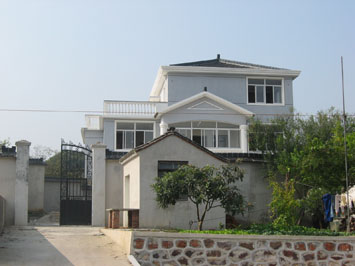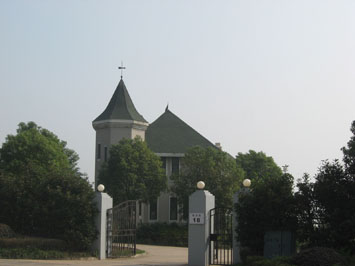As I sit here in Beijing Capital International Airport waiting for a flight to Taiyuan, I realize something universal about people. Whether in the suburbs of Shanghai, Beijing, Wuhan, Xi’an, Shenyang, Shenzhen, Guangzhou, Nanjing or even in the historical accident of Hong Kong, some of the most beautiful single-family detached housing in the world is here. It is not extensive, because it is not affordable to the great majority of Chinese. The Chinese call them “villas.” It is, however, the most expensive of housing and a goal to which many of the nation’s rising entrepreneurial class aspire.
It may be that it was called a dream first in America, but its beginnings go back much further. For much of human history, most people who lived in large cities were forced to put up with virtually inhuman densities. By definition, large cities were compact. Indeed, they were often not a lot larger in their geographical expanse than smaller cities. Why? To be efficient labor markets, cities had to be small, so that all of the workers could get to all of the jobs – and in those days the only way to get around was by foot. As cities got larger, especially during the industrial revolution, densities rose in some neighborhoods to 200,000 and more per square mile. The lower East Side of New York topped out at 375,000 in the 1910 census and has since dropped by 75 percent.
 The lack of sewers, clean water and the rampant filth bred disease and discomfort far beyond that experienced by any in today’s America, or for that matter today’s Europe, Japan or any other developed world country. The residents put up with it because it was better than staying in the countryside where there were fewer jobs, opportunities, or any hope for a better life. It says much about how difficult rural life was.
The lack of sewers, clean water and the rampant filth bred disease and discomfort far beyond that experienced by any in today’s America, or for that matter today’s Europe, Japan or any other developed world country. The residents put up with it because it was better than staying in the countryside where there were fewer jobs, opportunities, or any hope for a better life. It says much about how difficult rural life was.
But not everyone lived in such crowded conditions. Throughout history, the most wealthy have had their castles, estates and mansions. This was true in the cesspool of 19th century American and European industrial cities, just as it was in Rome.
The coming of mechanized transport, especially urban and suburban commuter rail systems changed all this. In the latter half of the 19th century the upper middle class began to enjoy a small modicum of estate life. These communities were set in places like Riverside in Chicago and Llewelyn Park in New Jersey and even the semi-detached housing suburbs of outer London. In these places, better transport made it possible for a larger share of the population to live without urban crowding, with their own private grounds, however humble.
 Transport was to get even better and, as a result, the suburban option spread. The popular, modern start of the mass-produced automobile oriented suburb was Bill Levitt’s Levittown, built in a Long Island potato field. These modest less than 750 square foot homes, with their yard, seemed nothing less than estates to the thousands of military personnel and others who gave the name to the American Dream. Levitt and Detroit had combined to make it possible. For the first time in history a large proportion of households to own their own, albeit miniaturized, castle.
Transport was to get even better and, as a result, the suburban option spread. The popular, modern start of the mass-produced automobile oriented suburb was Bill Levitt’s Levittown, built in a Long Island potato field. These modest less than 750 square foot homes, with their yard, seemed nothing less than estates to the thousands of military personnel and others who gave the name to the American Dream. Levitt and Detroit had combined to make it possible. For the first time in history a large proportion of households to own their own, albeit miniaturized, castle.
Although not quite estate link, the average home has grown, with the average size approaching 2,500 square feet. Many Levittown homes have been expanded to accommodate a more affluent lifestyle. All of it is what I like to call the democratization of prosperity – an unprecedented sharing of the wealth that started not far beyond the borders of New York City.
For the traveler interested in seeing urban areas beyond the touristic haunts, it is clear that the dream has expanded far beyond America. This is not surprising, because human beings, in general, seem to prefer their own space and will buy it if they can afford it. The Great Australian Dream involves detached housing that is nearly as large as new housing in the United States – even as planners struggle to force new houses on lots so small that a fire in one will likely spread to others. The large urban areas of suburbs from Canada to the United Kingdom, France, Japan, Sweden, Germany and all other developed nations all have experienced a rapid expansion of suburban living.
 The extent of the Universal Dream becomes even more compelling when one travels the developing world. Virtually the same pattern is evident in new suburbs of Beijing, Jakarta, Manila, Bangkok, Istanbul and Cairo. All have a smattering of single-family detached housing. Unlike the developed world, however, it cannot be afforded by much of the middle income population.
The extent of the Universal Dream becomes even more compelling when one travels the developing world. Virtually the same pattern is evident in new suburbs of Beijing, Jakarta, Manila, Bangkok, Istanbul and Cairo. All have a smattering of single-family detached housing. Unlike the developed world, however, it cannot be afforded by much of the middle income population.
None of this is to suggest that there are not some who would prefer a condominium on the upper East Side of New York, or in Chicago’s Gold Coast or in the precincts of the ville de Paris or the core of Stockholm. These people, however, constitute a minority, at least in part because a quality urban life comes with a price tag often far higher than that of the suburbs. For most people with middle class incomes, the best option remains a house that offers comfort, privacy and space at a price they can afford.
Wendell Cox is a Visiting Professor, Conservatoire National des Arts et Metiers, Paris and the author of “War on the Dream: How Anti-Sprawl Policy Threatens the Quality of Life”













I feel really happy to have
I feel really happy to have seen your webpage and look forward to so many more entertaining times reading here. Thanks once more for all the details. article
This is not surprising,
This is not surprising, because human beings, in general, seem to prefer their own space and will buy it if they can afford it. click to read
I need to to thank you for
I need to to thank you for ones time for this particularly fantastic read!! I definitely really liked every part of it and i also have you saved to fav to look at new information.. click for more
Choosing a full-time SEO
Choosing a full-time SEO professional might perhaps bring you the freedom to focus on getting larger your organization. click for more
SEO (Search Motor
SEO (Search Motor Optimization) is one of those individuals locations where companies are starting to pay additional attention to professionals with reliable coaching and documentation. next story
If a audience areas on an
If a audience areas on an content that is obviously badly published, even if it is about products or services they were looking, they will go on to other content or look for for different sites rather than yours. click reference link
buy datpiff downloads This
buy datpiff downloads This post was interesting and widens my knowledge especially in this field of subject you are discussing. I gained so much information in this site and also it gives us new insight about the topic that is being discussed increase instagram services
SEO Adelaide and other
SEO Adelaide and other little places generate is efficient. The outcomes speak for themselves. The websites produced by Adelaide centered companies using SEO have attracted guests from far and wide. overview
This is why public media is
This is why public media is so connected with regional SEO - it provides sources that are appropriate to the internet browser, in the particular location in which they are looking. visit site
A new web page has to do
A new web page has to do their best to get initial hyperlinks from excellent websites or weblogs and get observed. But once you start getting hyperlinks, be it through promotions or without even striving for them, most of other excellent websites will like to cover your items and place your weblink on their websites. important link